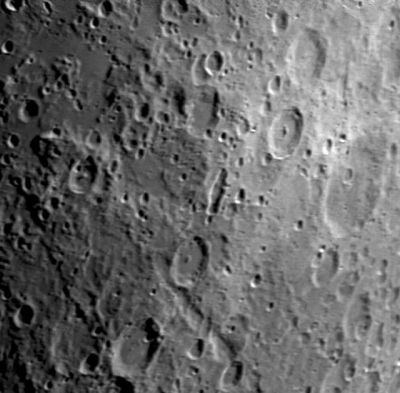Rheita
Contents
Rheita
|
Lat: 37.1°S, Long: 47.14°E, Diam: 70.81 km, Depth: 2.73 km, [/R%C3%BCkl%2068 Rükl: 68], [/Stratigraphy Nectarian] |
Table of Contents

Eric Soucy Rheita is at the lower center, with a central peak. The oblong formation at centre of photograph is Rheita E.
Images
LPOD Photo Gallery Lunar Orbiter Images Apollo Images
Maps
([/LAC%20zone LAC zone] 114B4) LAC map Geologic map
Description
Elger
([/IAU%20Directions IAU Directions]) RHEITA.--A formation, about 35 miles in diameter, S. of [/Reichenbach Reichenbach], with regular lofty walls, rising at a peak on the N.W. to a height of more than 14,000 feet above the interior, on which there is a small but prominent central mountain, a smaller elevation E. of the centre, and two adjoining craters at the foot of the S. wall. On the W. originates another fine valley, very similar to that already mentioned in connection with [/Reichenbach Reichenbach]. It runs in a S.S.E. direction, is about 100 miles in length, and, in its widest part, is about 12 miles across. Like the Reichenbach valley, it terminates at a small crater-like object, which has a border broken down on the side facing the valley, and a small central hill. About midway between its extremities, this great gorge is crossed by a wall of rock, like a narrow bridge.
Wikipedia
Additional Information
- IAU page: Rheita
- Depth data from [/Kurt%20Fisher%20crater%20depths Kurt Fisher database]
- Westfall, 2000: 2.73 km
- Viscardy, 1985: 4 km
- Cherrington, 1969: 4.41 km
- Satellite crater Rheita P is on the [/ALPO%20list%20of%20bright%20ray%20craters ALPO list of bright ray craters].
- Rheita E central peak height
- [/Sekiguchi%2C%201972 Sekiguchi, 1972]: two peaks both 1.0 km - fatastronomer fatastronomer
Nomenclature
- Named for Anton Maria Schyrleus of Rheita (1597-1660), a Czechoslovakian astronomer and optician. He developed several inverting and erecting eyepieces, and was the maker of Kepler’s telescope. "Things appear more alive with the binocular telescope," he wrote, "doubly as exact so to speak, as well as large and bright." His binocular telescope is the precursor to our binoculars.
- Rheita published one of the earliest maps of the Moon in his 1645 book Oculus Enoch et Eliae. The map was also on exhibit at the IMSS in Florence (see lower right for link to full text of book).
LPOD Articles
Bibliography
- Rheita's map: [/Whitaker Whitaker], pp. 47-48.
- Hill, Harold. 1991. [/Hill%2C%201991 A Portfolio of Lunar Drawings]., page 238 (the [/Neander Neander]-[/Reichenbach Reichenbach]-Rheita region at sunset).
[/Alphabetical%20Index Named Featues] -- Prev: [/Rhaeticus Rhaeticus] -- Next: [/Vallis%20Rheita Vallis Rheita]
This page has been edited 1 times. The last modification was made by - tychocrater tychocrater on Jun 13, 2009 3:24 pm - afx3u3